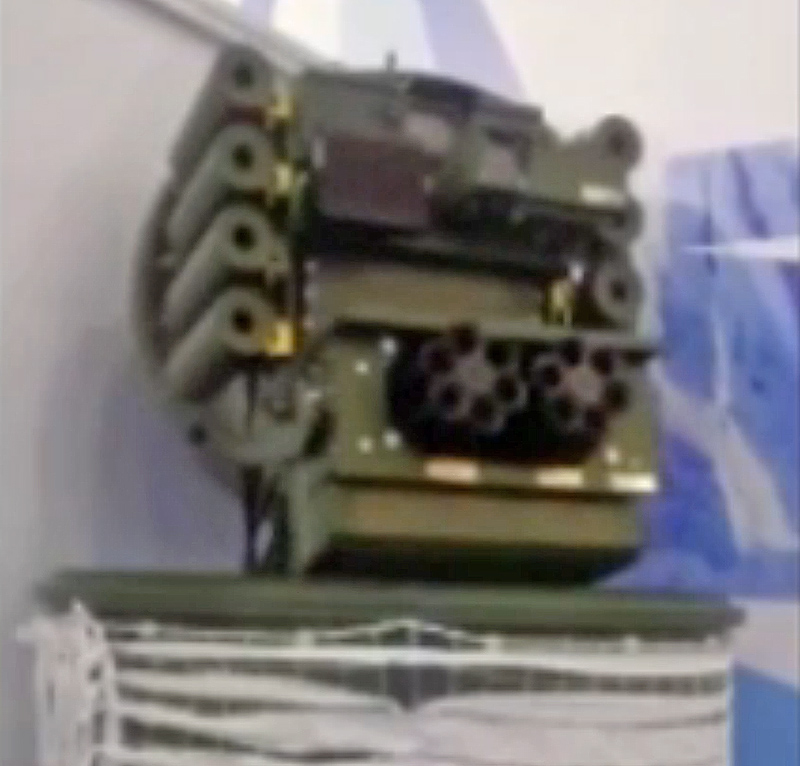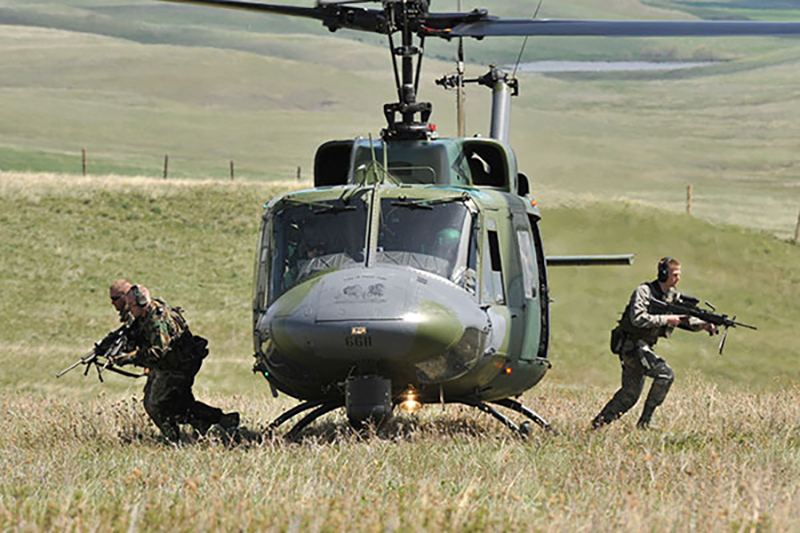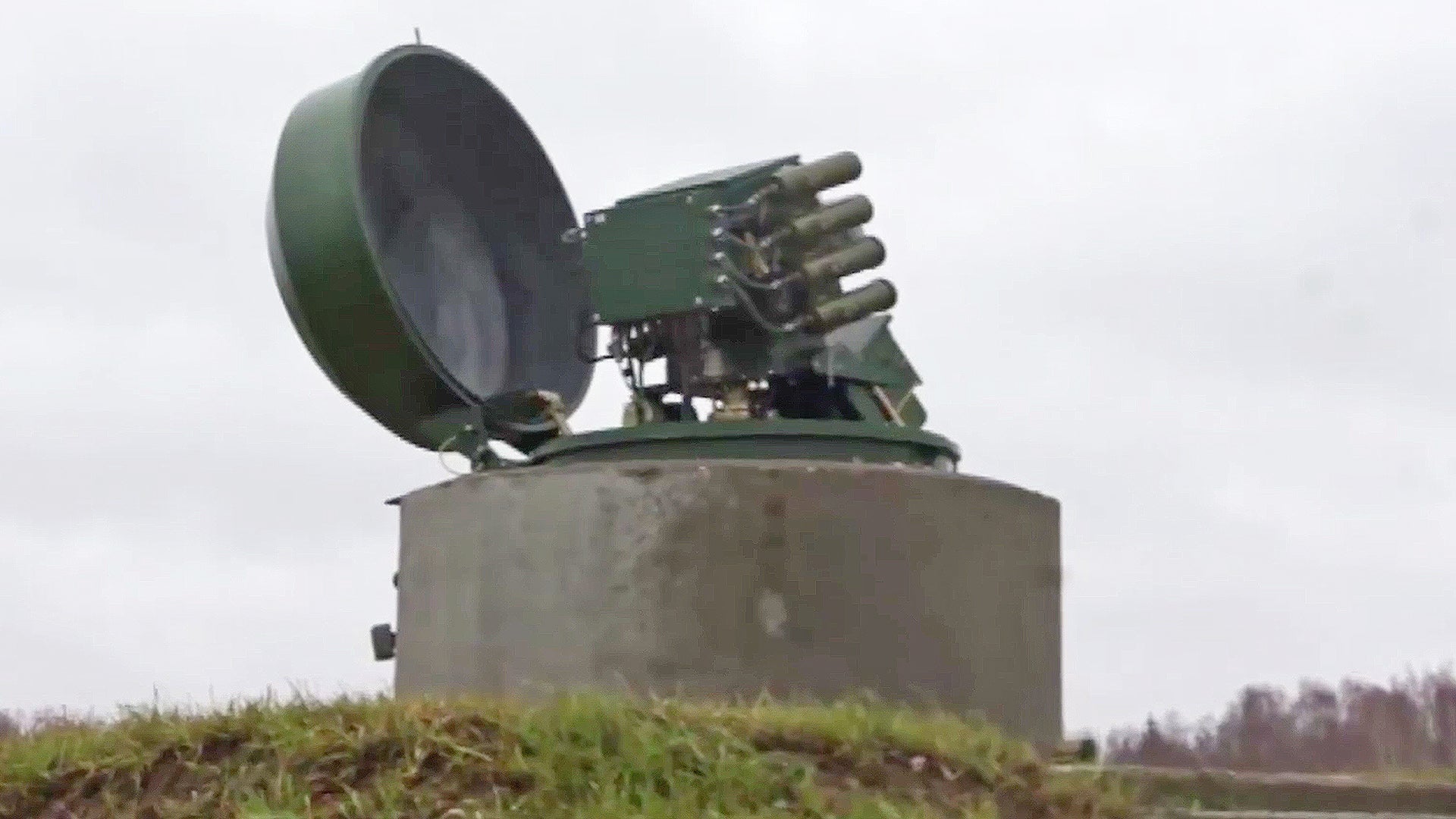Russia’s Strategic Missile Forces are slated to get a new robotic sentinel for their ICBM silo sites scattered across Russia. This new system looks like all those automated enemy defensive fortifications you ever blew to smithereens while smashing on the controller on your Nintendo back in the late ’80s. And although Russia loves to call any weapon without a human touching it a robot, it is really a remote controlled system, with a man in the loop fiddling a joystick and pressing the trigger.
The system is set into what looks like a concrete cylinder, and pops out of that cylinder within 30 seconds when activated. A large, hinged lid covers the system when not activated. Supposedly, the turret has radar and electro-optical sensors, as well as machine guns and grenade launchers to do the dirty work. Russia’s Ministry of Defense stated that the system, “if equipped with modern shooting and grenade launching systems… is capable of conducting aimed fire in a circular sector… at ranges of up to 400 meters.” So in essence we are talking about a very short-range point defense system.

The system is supposedly capable of detecting, tracking and engaging both ground targets, such as humans and vehicles, and low and relatively slow moving aerial targets, such as small unmanned air vehicles and helicopters. The system’s armament appears to include a pair of very short-barreled gatling guns similar to the 30mm OA-18 used on the AK-630 naval CIWS system. There also appears to be eight additional rocket propelled grenade tubes. These can likely deploy compact RPGs such as the RPG-26 or more modern RPG-30. The possibility of future upgrades to include small anti-armor guided missiles, such as the Kornet, would also be logical.

According to the system’s designer, Dmitry Perminov, the microwave radar can detect people at roughly four and a half miles away and a car up to seven miles away. Obviously the type of terrain where this system is installed will make a huge impact on its radar’s performance. The system’s concept is such that once detected by radar, it’s EO/IR cameras will snap to the target and a visual identification can be made before the decision is made to engage.
It seems very clear that Russia sees this system not just as a point defense sentry system for its most sensitive weapons sites, but also as a platform for monitoring border hotspots and to export on the commercial marketplace as well. Perminov states:
“This system can be applied not only as a military interface, but also for the protection of any strategic objects. Interest in it is not only limited to the military, but also in oil to control the pipeline and stop tapping and the theft of oil… We already had a real case during the system test. At some point the robot recorded the theft of electric cables. It filmed a video where a man was seen sawing a wire. A team was sent out and he was caught red-handed.”
Assuming this system, which supposedly has just passed initial trials, actually works as advertised, it may have some merit, although it seems that its design has clear limitations. First off, this thing has to be uncovered and scanning constantly for threats, meaning it has to be exposed, and considering the huge cap that pops open when it activates, that doesn’t seem to be the intention of the design.
Second, there still has to be a human operating the system once something is detected. Although one person could theoretically monitor multiple units at any given time from a collective control station, they can only actively control one unit at a time. So aside from offering a centralized command and control architecture, the system provides little efficiency as compared with just putting an operator in the field to near the system itself.
Then again, if missile silos are divided by long distances, a centralized command stations helps with the logistical challenges of moving people too and from each location. For smaller scale threats this type of setup could work, but what happens if multiple sites are attacked at the same time? Either manpower would need to be available to man each control stations, assuming there are enough control stations to begin with, or these systems could just sit idle during a multi-prong attack.
Finally, fixed defenses have their well established drawbacks, the biggest one being they are predictable. As a result tactics can be devised to overcome and overwhelm them.
Even with these operational issues in mind, this type of system could be useful in a similar role in the US. Currently roving patrols and quick reaction alert special tactics teams that deploy via helicopter provide security for America’s Minuteman ICBM fields located in North Dakota, Wyoming and Montana. Remote weapons and sensor stations like these could offer some persistent defensive capabilities to bolster more traditional forms of security, although decoupling the radar from the system’s optical sensors and weapons turret would be idea. This way a constant radar “picture” can be maintained while the turret is pointed in any direction, or even in a stowed position.

Where this type of system makes the most sense is in war zones, or areas that are extremely prone to assault. For instance, around critical infrastructure in places like Iraq and Afghanistan, although in many ways, human beings still offer a better sentry option than something like this. In fact, its greatest utility is more likely in the anti-drone role than anything else.
The idea that these could defend oil pipelines is a little erroneous as it would require a system every mile or less to provide persistent coverage, and it would only likely be plausible for extremely remote areas or in places that are largely lawless and the government is willing to allow contractors with remote weapons turrets to target whatever they deem a threat. Even then, they would only be used at points where critical infrastructure is located, not consistently along hundreds or even thousands of miles of pipeline.
The thing is that this system isn’t really that unique. Remote weapons turrets have been hot attractions at arms expos around the globe, and the US, along with other countries are playing with them to better understand their utility. Originally they were mainly designed for being mounted on armored vehicles and on ships, but now they are available for stationary applications, and some are even operational with water hoses instead of machine guns.

Russia’s integration of a microwave radar with a system like this is interesting, along with some fairly inexpensive munitions. The Apache’s Longbow radar system could potentially be adapted for a similar role for a western design, one that would likely be far more capable than this and would even be capable of firing missiles in any weather at targets up to a couple of miles away. If located in a central and elevated position, like atop a high pole, the radar could even direct multiple units spread over a multiple square miles and provide persistent 360 degree coverage and even targeting for those remote weapons stations.
It all comes down to applications and cost. This type of remote weapons application does not have as broad a utility as some may think after quick glance, but the arms industry definitely sees a market for them. With this in mind, it will be interesting to see where Russia’s remote weapons turret, and many others in development, “pop up” in the coming years.
Contact the author Tyler@thedrive.com
